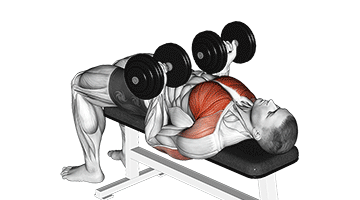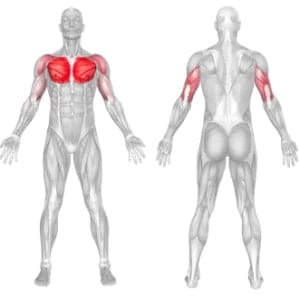Dumbbell Bench Press
Exercise / Chest
Dumbbell Bench Press
The dumbbell press is a classic upper-body strengthening exercise that works your chest. Your chest muscle are the main muscles targeted by the exercise, but as an added bonus it also works your anterior deltoid and triceps. It is an alternative to the barbell bench press and offers some unique benefits due to the use of individual dumbbells.
How to do :

following these tips and tricks
- Setup:
- Lie flat on a bench with your feet firmly planted on the ground.
- Lie Hold a dumbbell in each hand, resting them on your thighs.
- Starting Position:
- Using a controlled motion, bring the dumbbells up to shoulder level while sitting on the bench. This is your starting position.
- Your palms should be facing forward, and your wrists should be in a neutral position.
- Execution:
- Inhale and engage your core muscles.
- Slowly lower the dumbbells towards your chest in a controlled manner, keeping your elbows at about a 45-degree angle to your body. Your upper arms should be parallel to the floor.
- Lower the dumbbells until your elbows are slightly below the bench level or until you feel a gentle stretch in your chest muscles.
- Pushing Phase:
- Exhale and push the dumbbells back up to the starting position, fully extending your arms without locking your elbows.
- Keep your chest engaged and maintain a slight arch in your lower back throughout the movement.
- Repeat:
- Perform the desired number of repetitions, maintaining proper form and control.
Benefits of bench press
- Muscle Building: The dumbbell bench press primarily targets the pectoral muscles (chest), helping to develop size and strength in the chest area. It also engages the anterior deltoids (front shoulders) and triceps, contributing to overall upper body muscle development.
- Balanced Muscle Engagement: Unlike the barbell bench press, which can sometimes lead to muscle imbalances due to the dominant arm taking over, the dumbbell bench press allows each arm to work independently. Balancing and controlling two separate dumbbells requires more stabilization from the supporting muscles. This helps in balancing muscle development and addressing any strength discrepancies between the sides.
- Joint Health: The dumbbell bench press can be gentler on the shoulders and wrists compared to the barbell bench press. This can reduce the risk of joint strain or discomfort, especially for individuals with existing shoulder issues.
- Range of Motion: Dumbbells allow for a greater range of motion compared to a barbell, as each arm can move independently. This can lead to better muscle stretch and contraction, enhancing muscle growth and flexibility.
dumbbell bench press – Muscles Worked

0 %
Target - Pectoralis Major, Sternal
0 %
Synergists - Clavicular
0 %
Synergists - Anterior Deltoid
0 %
Synergists - Triceps Brachii
0 %
Dynamic Stabilizers - Biceps Brachii
